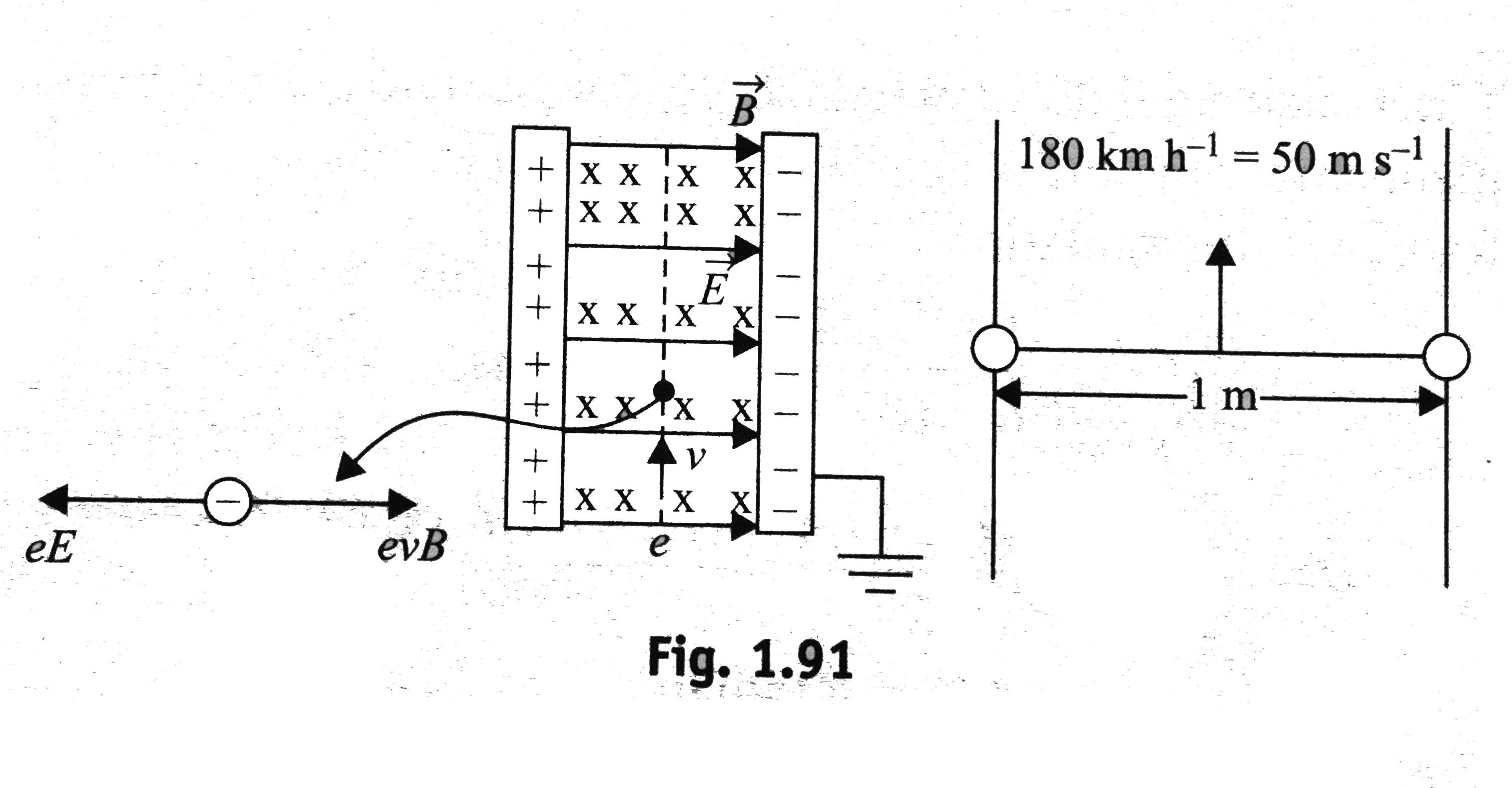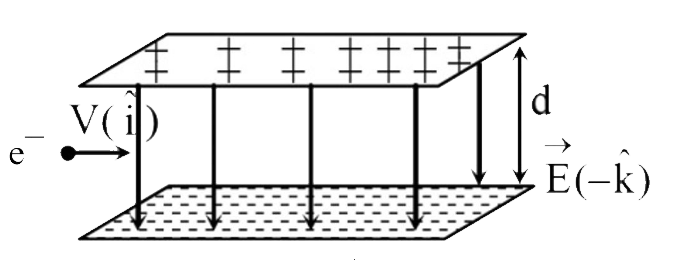A potential difference of 600vo<s is applied across the plates of a parallel plate consenser . The separation between the plates is 3mm. An electron projected vertically, parallel to the plates , with a velocity of 2×106m/sec moves underflected between the plates. Find the magnitude and direction of the magnetic field in the region between the condenser plates. ( Neglect the edge effects). ( Charge of the electron = -1.6xx10^(-19) coulomb)

The force on electron will be toward the left plane due to electric field and will be equal to Fe=eE.
For the electron to move undeflected between the plates, there should be a force (magnetic) which is equal to the electric force and opposite in direction to electric force. So the force should be directed toward the right as the electric force is toward the left. On applying Fleming's left hand rule, we get that the magnetic field should be directed perpendicular to the plane of paper and inwards. Therefore,
Force due to electric field=Force due to magnetic field
eE=evB[∵E=Vf]
B=Ev=V/dv

where V=potential difference between the plates, and
d=distance between the plates
B=600/3×10−32×106=6003×10−3×2×106⇒B=0.1T
Topper's Solved these Questions
- BOOK - CENGAGE PHYSICS ENGLISHCHAPTER - MAGNETIC FIELD AND MAGNETIC FORCESEXERCISE - Exercise 1.122videos
MAGNETIC FIELD AND MAGNETIC FORCES
- BOOK - CENGAGE PHYSICS ENGLISHCHAPTER - MAGNETIC FIELD AND MAGNETIC FORCESEXERCISE - Exercise 1.213videos
MAGNETIC FIELD AND MAGNETIC FORCES
- BOOK - CENGAGE PHYSICS ENGLISHCHAPTER - MAGNETIC FIELD AND MAGNETIC FORCESEXERCISE - Multiple Correct Answer type2videos
MAGNETIC FIELD AND MAGNETIC FORCES
- BOOK - CENGAGE PHYSICS ENGLISHCHAPTER - INDUCTANCEEXERCISE - Concept Based8videos
INDUCTANCE
- BOOK - CENGAGE PHYSICS ENGLISHCHAPTER - MISCELLANEOUS VOLUME 3EXERCISE - True and False3videos
MISCELLANEOUS VOLUME 3
Similar Questions
A potential difference of 600 V is applied across the plates of a parallel plate condenser. The separation between the plates is 3 mm. An electron projected vertically, parallel to the plates, with a velocity of 2×106m/s moves undeflected between the plates. Find the magnitude of the magnetic field (in T) in the region between the condenser plates. (Neglect the edge effects) □ .
(Charge of the electron =1.6×10−19C)
 View Solution
View SolutionTo reduce the capacitance of parallel plate capacitor, the space between the plate is
View Solution
Knowledge Check
- Question 1 - Select One
As the distance between the plates of a parallel plate capacitor decreased
AIf both assertion and reason are ture and reason is the correct explanation of assertion.BIf both assertin and reason are ture but reason is not the correct explanation of assertion .CIf assertion is true but reason is false.DIf both assertion and reason are false.
What is the area of the plates of a 2 farad parallel plate air capacitor, given that the separation between the plates is 0.5 cm?
View SolutionWhat is the area of the plates of a 2 farad parallel plate air capacitor, given that the separation between the plates is 0.5 cm?
View SolutionForce of attraction between the plates of a parallel plate capacitor is
View SolutionThe parallel plate capacitor has potential difference of 100 V and separation between the plate is 1 mm. An electron is projected along x axis in between the plates. If the electron comes out of the plates along the x axis undevated then the magnitude and direction of magnetic field that must be applied between the plates : (particle is projected with a velocity of 105m/s along x axis)
 View Solution
View SolutionThe plates of a parallel plate capacitance 1.0 F are separated by a distance d =1 cm. Find the plate area .
View SolutionIf the separation between the plates of a capacitor is 5 mm , then area of the plate of a 3 F parallel plate capacitor is
View SolutionThe separation between the plates of a charged parallel-plate capacitor is increased. The force between the plates
View Solution

